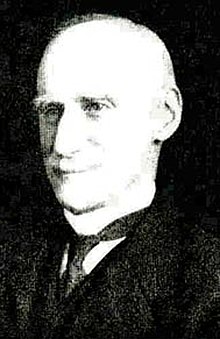William Bywater Grove (24 October 1848 – 6 January 1938), was an English biologist, in particular a botanist and microbiologist. He is remembered in particular as a mycologist. He died in 1938 on the sixth of January when he was 89.[1]

Early life and teaching career
editHe was born in Birmingham, England. From 1887 to 1900 he was headmaster of the St Edmunds High School for boys, Birmingham. One of the pupils at that school during that period was Augustus Daniel Imms, a prominent entomologist. From 1905 to 1927 Grove lectured in botany at Birmingham Municipal Technical School.[1]
Research work and publications
editGrove was the Honorary Curator of the Fungus Herbarium at the University of Birmingham.[1]
He received the Midland Union of Natural History Societies's Darwin Medal in 1884, for "for a monograph on the Pilobolidæ and other botanical papers", published in their journal, The Midland Naturalist.[2]
Grove's publications include:
- 1884. On the Pilobolidæ, With a Synopsis of the European Species, and a Description of a New One. The Midland Naturalist 7:131-135,149-153,184-187,214-220,253-260,280-284,304-309,333-339 and plates VI & VI.
- 1884. A Synopsis of the Bacteria and Yeast Fungi and Allied Species (Schizomycetes and Saccharomycetes).[3]
- 1886. The Fungi, in Handbook of Birmingham prepared for the members of the British Association, pp. 339
- 1888. A description of a new species of mushroom, Russula claroflava.[4]
- 1891. (With James Eustace Bagnall) "Fungi", in The Flora of Warwickshire.[5]
- 1910. The Mycetozoa (in the series The Fauna of the Midland Plateau).[6]
- 1913. The British Rust Fungi (Uredinales) : their Biology and Classification.[7]
- 1915. A Pocket Synopsis of the Families of British Flowering Plants (based upon the system of Engler).[8]
- 1935–1937. British Stem- and Leaf-Fungi (Coelomycetes), in 2 volumes.[9][10]
- He translated the mycological treatise of Louis Rene and Charles Tulasne, Selecta Fungorum Carpologia[11] into English.
See also
editReferences
edit- ^ a b c New York Botanical Garden Archives. Grove, W.B. (William Bywater), 1848–1938 [1]
- ^ "The Darwin Medal". The Gardeners' Chronicle: 51. 9 July 1887.
- ^ Grove, W.B. (1884). A Synopsis of the Bacteria and Yeast Fungi and Allied Species (Schizomycetes and Saccharomycetes. London: Chatto & Windus. OCLC 13202182. Retrieved 2015-01-20.
- ^ Grove, W.B. (1888). "Wayside Notes". The Midland Naturalist. 11: 265–266. Retrieved 2015-01-20.
- ^ Grove, W.B. & Bagnall, J.E. (1891). "Fungi". In Bagnall, James E. (1891). Flora of Warwickshire. London: Gurney & Jackson. OCLC 15190032. pp. 387–465.
- ^ Grove, W.B. (1910). The Mycetozoa. The Fauna of the Midland Plateau. Birmingham: Birmingham Natural History & Philosophical Society. OCLC 45548734.
- ^ Grove, W.B. (1913). The British Rust Fungi (Uredinales) : their Biology and Classification. Cambridge University Press. OCLC 811975170. Retrieved 2015-01-20.
- ^ Grove, W.B. (1915). A Pocket Synopsis of the Families of British Flowering Plants (based upon the system of Engler). Manchester University Press. OCLC 16352181. Retrieved 2015-01-20.
- ^ Grove, W.B. (1935). British Stem- and Leaf-Fungi (Coelomycetes): Volume I Sphaeropsidales. Cambridge University Press. Retrieved 2015-01-20.
- ^ Grove, W.B. (1937), British Stem- and Leaf-Fungi (Coelomycetes): Volume II Sphaeropsidales ... and Melanconiales, Cambridge University Press, retrieved 2015-01-20
- ^ Three volumes available online at [2], [3], [4]
- ^ International Plant Names Index. Grove.
External links
edit